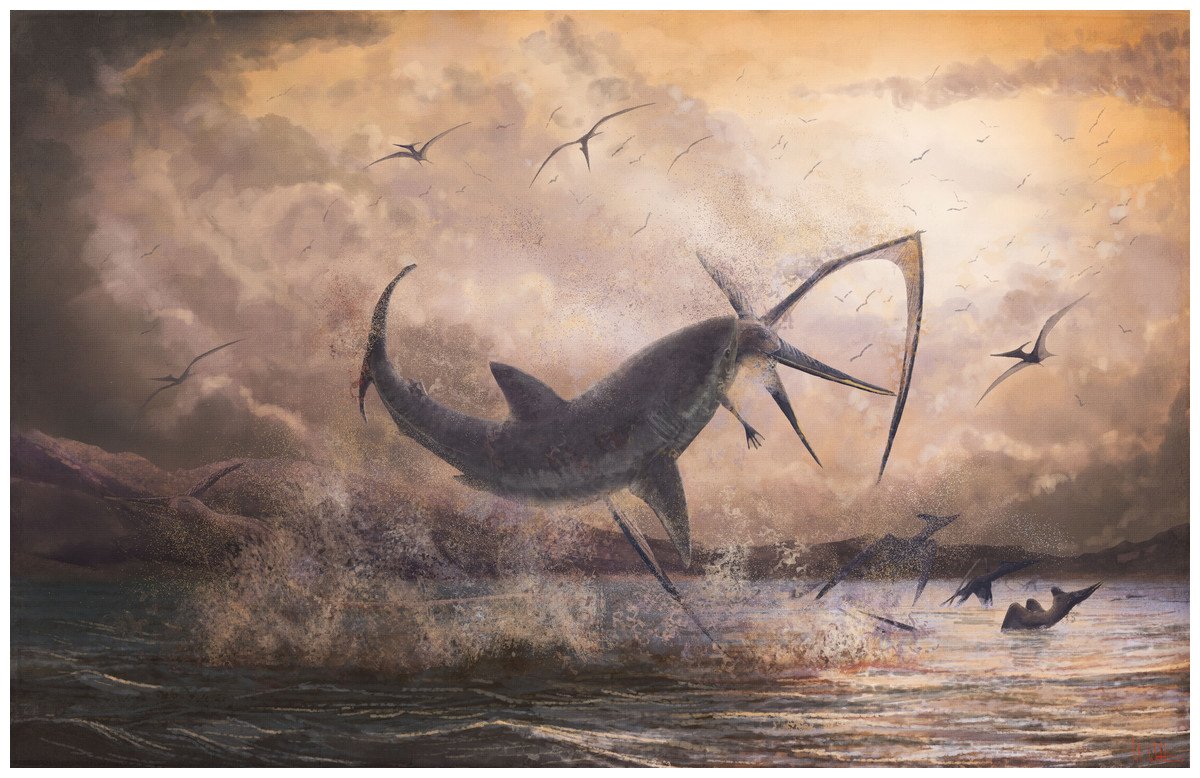
Shark vs Pterosaur. By Mark Witton.
Over the last 10 years I have published quite a few papers on various feeding traces, shed teeth and stomach contents that help demonstrate and refine some understandings about who ate who in the Mesozoic. These are often very interesting but also frustratingly incomplete and it can be hard to identify one, let alone both, of the protagonists and in any case these are often isolated examples that may or may not represent wider trends. Still, at least sometimes there can be a good set of marks with repeated patterns and enough data to be quite confident about a relationship.
One such is that between the classic giant pelagic pterosaur Pteranodon and various sharks from the Cretaceous, most notably Squalicorax. This is no big surprise, these pterosaurs were spending a large amount of time out over the water and could probably dive and swim after prey, even if they didn’t likely sit for long on the surface when they did so. Even aside from the possibility of being caught, at least some pterosaurs must have died while out over the water or been stranded and ill or injured on the surface and that would inevitably attract large predators to come for a meal. Given the huge numbers of Pteranodon bones we have, it should not then be a surprise that there are a good number of them described with various bite marks that can be confidently attributed to large sharks. Pterosaurs were generally lightweight for their size but that doesn’t mean there was not some decent muscle on them and modern seabirds are not infrequently eaten by sharks providing a nice analogy too.

‘Complete’ Pteranodon at the LACM.
Such data though is limited to marks on bones and it’s always nice to have something more detailed than this. Although mentioned before in several previous papers, one outstanding Pteranodon specimen in LA has never been described or illustrated properly and so when I got my hands on it while visiting Mike Habib a few years ago, it was rather inevitable that something would happen, and the paper on that, with the healthy addition of Mark Witton as a collaborator, is now out.
The indivdual in question is mounted as a lovely complete (and sort of 3-D) pterosaur on display in the Los Angeles County Museum but it is a composite of somewhat indeterminate origin and it’s not entirely clear how many individuals were used to make it or how complete any of them were. What is clear though is that there is a short series of articulated cervical vertebrae and that these have the tooth of a decently sized shark with them. It’s trapped under a prezygopophysis so it’s hard to think it just drifted in there by chance onto a skeleton at the very bottom of the sea, and while the tooth doesn’t look like it penetrates the bone it is a reasonable interpretation that this is a shed tooth from a bite.
The tooth is diagnostic of the large pelagic shark Cretoxyrhina and we have a good enough idea of where in the mouth it sat which means we can get decent estimates of the sizes of each of the two animals here. The Pteranodon clocks in at around 5 m in wingspan with the shark being 2.5 m in length, but despite this apparent discrepancy, the shark would have been by far the heavier animal and in the water it would swim rings round the pterosaur. In short, while we don’t know quite what happened here (was it predation or scavenging) it looks like a decent sized shark took a chunk out of a pterosaur and lost a tooth in the process.
This is the first record of sucha trophic relationship between these two genera, though of course various unattributed bites that are already known might also have been made by Cretoxyrhina. However, despite the large numbers of Pteranodon specimens known, apparent bites on them turn up in only about 1% of cases. In some ways this may sound like a lot but there’s perhaps a 6% rate of carnivore-consumed interactions known for Rhamphorhynchus, so the open ocean (perhaps unsurprisingly) might have had fewer incidences of large predators getting to grips with large pterosaurs than near shore ones with much smaller animals.
All in all though, this adds a nice new point to the dataset on pterosaurs and their position in various food chains. We have a healthy record of them eating things, and being eaten, and each new bit of data like this helps us get a better and better handle on how pterosaurs fitted into ecosystems and how they might have lived, and died, in the Mesozoic.
The paper is fully OA and available here.

You are living the life I dreamed of as a teenager. Congratulations on your paper and on bringing to life the ancient past.